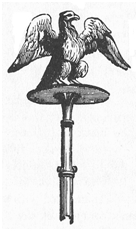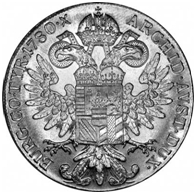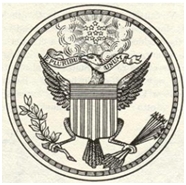The American Eagle
We see the American Bald Eagle on our coins, dollar bills, and the caps of our military officers. It is perched as the top ornament or finial on flag staffs displaying the Stars and Stripes. We recognize the bald eagle as our national emblem so readily that we may not even ask the obvious questions: why the eagle, where did it come from and what is its history?
Having dominion over other birds of the air, the eagle became the symbol of power and authority in ancient times. Both Greeks and Romans associated the eagle with their gods. For the Roman Legions, the eagle developed into their Aquila, their Eagle Standard. This tied the eagle, as a symbol, to the Roman Empire and empires that came after it.
Charlemagne selected the eagle to symbolize the Holy Roman Empire. By the time of the American Revolution, the empires of continental Europe used the eagle as the symbol of empire. The British did not use the eagle as a symbol of empire, but it was well established in the heraldry of continental Europe. The Americans saw themselves as a new empire taking a place among the empires of the world.
In 1782, when congress adopted a national seal, it was logical that they should choose a symbol that recognized their new status as the American Empire. Charles Thompson, the secretary of the Congress, suggested the eagle for the new Great Seal. He had likely seen coins of European empires that depicted eagles with a shield on their breasts. The Maria Theresa Thaller, a coin of the Austrian Empire first issued in 1780, is a good example of this.
Although Congress considered several different designs for the new seal, they adopted a seal showing the American shield “on the breast of the American bald Eagle.” This new American Empire, composed of thirteen free and independent states, had a Great Seal mirroring the seals of other empires.
Today, we don’t think in terms of empire as the Founding Fathers did. That was an idea important in the eighteenth century. Today, the idea of the American Republic is more important, a form of government where the power and authority of the nation is derived, not from a king or emperor, but from the people. The word republic comes from a Latin phrase, res publica, which means “in the matter of the people.” Royal proclamations began: “We, George III….” However, our Constitution begins, “We the People….”
When we look at a flag staff displaying the Stars and Stripes, we see a top ornament, the Eagle, which looks very much like the Aquila or Eagle Standard of the Roman Legions. It reminds us of our birth as a nation. We may not now consider our nation as an empire, but the American Republic has taken its place among the powers of the earth.



